外研版(2019)必修第三册Unit 5 What an adventure! Understanding ideas 课件(28张ppt)
文档属性
| 名称 | 外研版(2019)必修第三册Unit 5 What an adventure! Understanding ideas 课件(28张ppt) |  | |
| 格式 | pptx | ||
| 文件大小 | 39.1MB | ||
| 资源类型 | 教案 | ||
| 版本资源 | 外研版(2019) | ||
| 科目 | 英语 | ||
| 更新时间 | 2022-10-30 09:54:47 | ||
图片预览

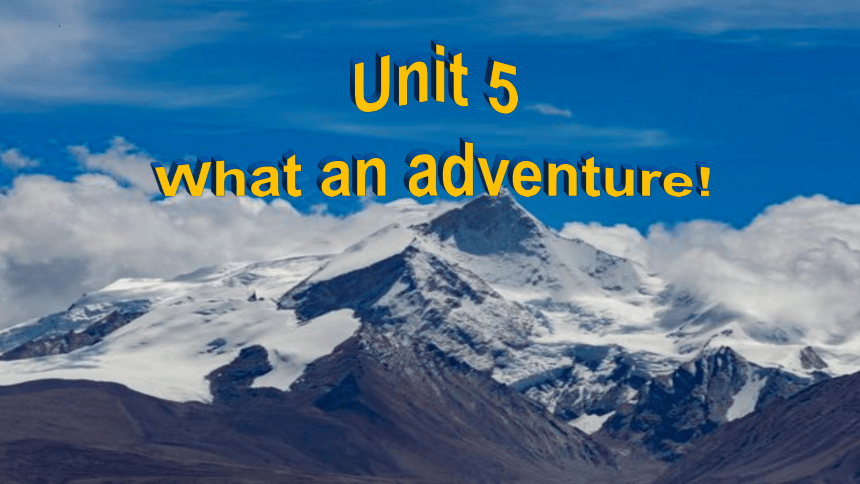

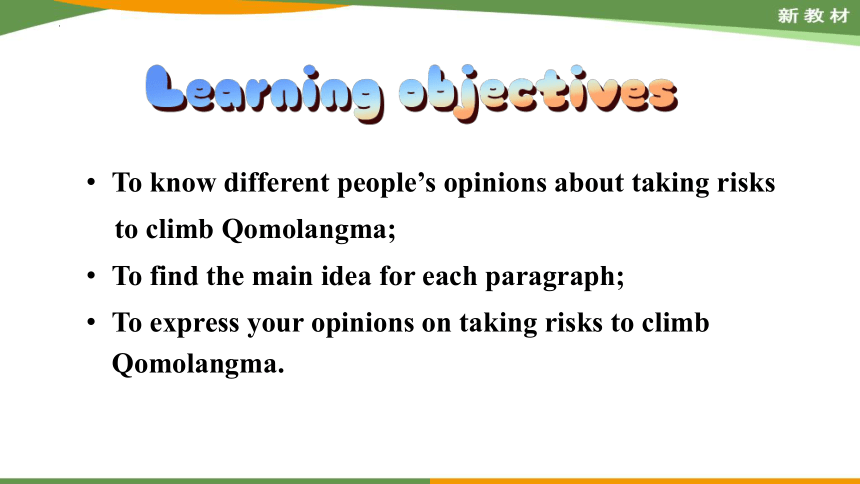

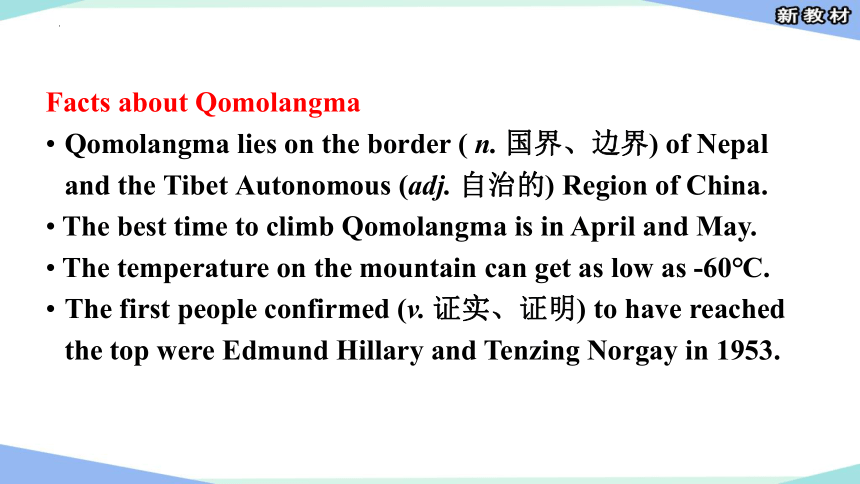
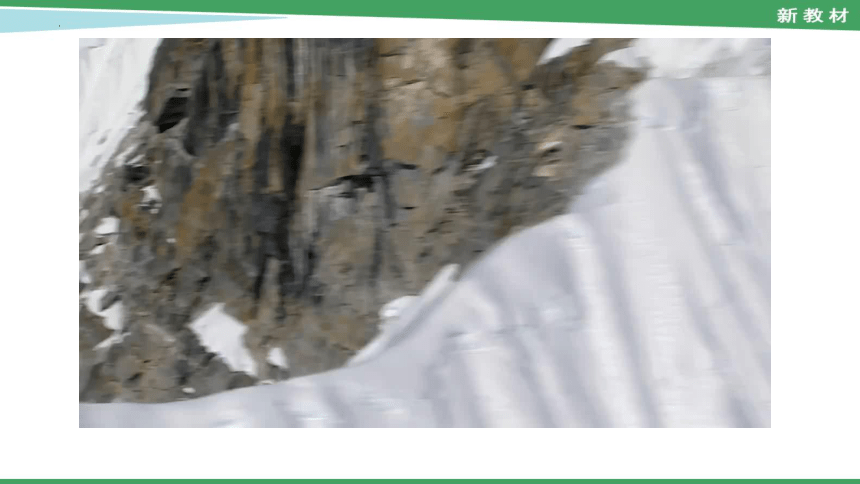
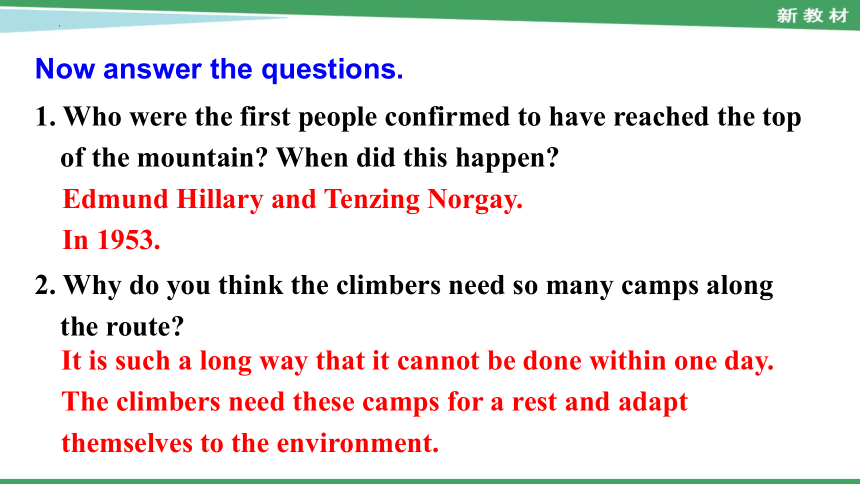
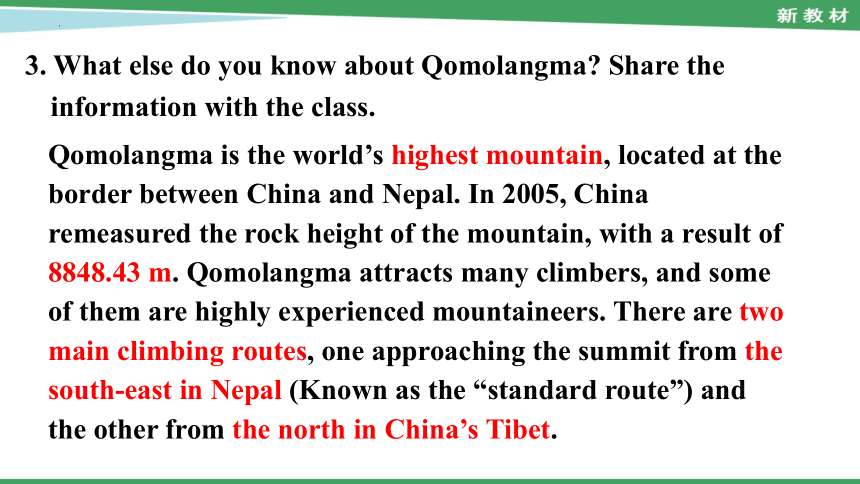
文档简介
(共28张PPT)
Unit 5
Unit 5
What an adventure!
To know different people’s opinions about taking risks
to climb Qomolangma;
To find the main idea for each paragraph;
To express your opinions on taking risks to climb Qomolangma.
What do you know about Qomolangma Why do people want to reach the top of the mountain Look at the map and read some facts about Qomolangma. Then view a video to find more.
Facts about Qomolangma
Qomolangma lies on the border ( n. 国界、边界) of Nepal and the Tibet Autonomous (adj. 自治的) Region of China.
The best time to climb Qomolangma is in April and May.
The temperature on the mountain can get as low as -60℃.
The first people confirmed (v. 证实、证明) to have reached the top were Edmund Hillary and Tenzing Norgay in 1953.
1. Who were the first people confirmed to have reached the top of the mountain When did this happen
Edmund Hillary and Tenzing Norgay.
In 1953.
Now answer the questions.
2. Why do you think the climbers need so many camps along the route
It is such a long way that it cannot be done within one day. The climbers need these camps for a rest and adapt themselves to the environment.
3. What else do you know about Qomolangma Share the information with the class.
Qomolangma is the world’s highest mountain, located at the border between China and Nepal. In 2005, China remeasured the rock height of the mountain, with a result of 8848.43 m. Qomolangma attracts many climbers, and some of them are highly experienced mountaineers. There are two main climbing routes, one approaching the summit from the south-east in Nepal (Known as the “standard route”) and the other from the north in China’s Tibet.
Alan Arnette
American journalist and mountaineer. His last expedition was to summit of the world’s 8th highest peak, Manaslu at 26,759 (8156m) in Nepal on October 25, 2013.
Each year, many mountaineers / climbers come to Qomolangma to challenge themselves. Here are some.
He began mountain climbing at age 38 with a summit of Europe’s Mont Blanc. From there he went on to climb some of the world’s highest peaks. He has now completed over 35 major expeditions around the world.
George Mallory (1886~1924)
British explorer and mountaineer who was a leading member of early expedition to Mount Qomolangma.
He is remembered for his famous reply to a reporter’s question about why he wanted to climb Mount Qomolangma “Because it’s there!”.
Read the passage “Climbing Qomolangma: worth the risks ”
本文语篇类型为专栏文章,通过举例与引用几位探险家和心理学家说的话,分析探险家的探险“天性”和探险活动的价值。
Read the passage and find out what “Type T” personalities are.
“Type T” personalities, with the “T” standing for “thrill”, are personality traits that make people more likely to take risks than others.
Choose the author’s purpose in writing the passage.
1. To encourage people to climb Qomolangma if fully prepared, as risks bring many benefits.
2. To remind people to balance the benefits and risks before deciding to climb Qomolangma.
3. To suggest that people stop taking risks and climbing Qomolangma, as the risks outweigh the benefits.
Outline of the passage
Introduction of climbing Qomolangma (Para.1)
Two famous climbers’ opinions (Paras. 2-3)
Scientific reason behind the risk-taking (Paras. 4-6)
Conclusion: ask for your opinions (Para. 7)
Match the main idea with each paragraph.
Para. 1
Para. 2
Para. 3
Para. 4
Para. 5
Para. 6
Para. 7
There is also a scientific reason behind the risk-taking.
Mountain climber Alan Arnette.
“Type T” personalities.
It is up to you whether the benefits of climbing Qomolangma worth the risk.
Our desire relates to expectation.
Mountain climber George Mallory.
Climbing Qomolangma is a unique experience.
Complete the paragraphs with the expressions from the passage.
Why Do People Climb Qomolangma
George Mallory
What people get from this adventure is just __________. People eat and make money to be able to _________, not the other way round.
sheer joy
enjoy life
Alan Arnette
Each person has a (n) __________________ reason for climbing a mountain. It forces people to __________________ themselves. To succeed, people must have the physical as well as __________________.
important and unique
look deep inside
mental toughness
Scientific reasons
Risk-taking may be part of _______________. People who are more likely to ________________ have “Type T” personalities. Research also suggests that our desire to seek risks can be connected to how much we expect to ___________________.
human nature
take risks
benefit from the result
Match the famous people with their ideas.
a. The personalities of people who prefer taking risks are “Type T”.
b. There are a thousand reasons to turn around and only one to keep going.
c. We eat and make money to be able to enjoy life.
d. People really need the physical and mental toughness to keep going.
e. People who are looking for adventures just desire to experience joy.
f. The “Type T” personalities don’t want to die and they don’t expect to die.
George Mallory
Alan Arnette
Frank Farley
Choose the right item from the box and make the summary complete. Change the form when necessary.
human nature, result, look, joy, powerful
For some people, climbing Qomolangma is an experience like no other, making some feel weak and others, 1. _________. British mountain climber George Mallory wrote of climbing Qomolangma, “What we get from this adventure is just sheer 2. ________.” The American mountain climber Alan Arnette, who climbed Qomolangma in 2011,
powerful
joy
human nature, result, look, joy, powerful
said that the reason for climbing forces people to 3. ___________ inside themselves and in order to succeed, people must have the physical and mental toughness. Recent studies indicate that risk-taking may be part of 4. _____________. Psychologist Frank Farley refers to the personalities of these people as “Type T”, with the “T” standing for “thrill”. Research also suggests that our desire to seek risks can be connected to how much we expect to benefit from the 5. _____________.
look
human nature
result
“积极——消极”模式
“积极——消极”模式(positive-negative pattern)由两部分组成:积极部分和消极部分。这两部分在语篇中出现的顺序比较灵活,可以是积极部分在前,也可以是消极部分在前,二者之间往往由衔接过渡句连接。本文的首段就采用了消极部分在前的组篇方法。请大家仔细阅读第一段,来从文中找出相应的依据。
Reading strategies
文章第一段的前两句中出现了不少表示消极意义的词,如:crowds,discomfort,danger,sick,extreme cold,low air pressure,lose their lives。这些词向读者传达了一个消极的信息——攀登珠穆朗玛峰是很危险的。紧接着,作者使用一个过渡句:Yet, despite all this, by the end of the trip many were already planning to return. 将文章转移到积极部分,借助an experience like no other和powerful告诉读者攀登珠峰也有其积极的一面。
1. Do you agree with Mallory’s and Arnette’s opinions Why
2. If you were given the chance, would you like to climb Qomolangma Why or why not
Write a short passage about your adventure experience or dream. (at least 100 words)
Unit 5
Unit 5
What an adventure!
To know different people’s opinions about taking risks
to climb Qomolangma;
To find the main idea for each paragraph;
To express your opinions on taking risks to climb Qomolangma.
What do you know about Qomolangma Why do people want to reach the top of the mountain Look at the map and read some facts about Qomolangma. Then view a video to find more.
Facts about Qomolangma
Qomolangma lies on the border ( n. 国界、边界) of Nepal and the Tibet Autonomous (adj. 自治的) Region of China.
The best time to climb Qomolangma is in April and May.
The temperature on the mountain can get as low as -60℃.
The first people confirmed (v. 证实、证明) to have reached the top were Edmund Hillary and Tenzing Norgay in 1953.
1. Who were the first people confirmed to have reached the top of the mountain When did this happen
Edmund Hillary and Tenzing Norgay.
In 1953.
Now answer the questions.
2. Why do you think the climbers need so many camps along the route
It is such a long way that it cannot be done within one day. The climbers need these camps for a rest and adapt themselves to the environment.
3. What else do you know about Qomolangma Share the information with the class.
Qomolangma is the world’s highest mountain, located at the border between China and Nepal. In 2005, China remeasured the rock height of the mountain, with a result of 8848.43 m. Qomolangma attracts many climbers, and some of them are highly experienced mountaineers. There are two main climbing routes, one approaching the summit from the south-east in Nepal (Known as the “standard route”) and the other from the north in China’s Tibet.
Alan Arnette
American journalist and mountaineer. His last expedition was to summit of the world’s 8th highest peak, Manaslu at 26,759 (8156m) in Nepal on October 25, 2013.
Each year, many mountaineers / climbers come to Qomolangma to challenge themselves. Here are some.
He began mountain climbing at age 38 with a summit of Europe’s Mont Blanc. From there he went on to climb some of the world’s highest peaks. He has now completed over 35 major expeditions around the world.
George Mallory (1886~1924)
British explorer and mountaineer who was a leading member of early expedition to Mount Qomolangma.
He is remembered for his famous reply to a reporter’s question about why he wanted to climb Mount Qomolangma “Because it’s there!”.
Read the passage “Climbing Qomolangma: worth the risks ”
本文语篇类型为专栏文章,通过举例与引用几位探险家和心理学家说的话,分析探险家的探险“天性”和探险活动的价值。
Read the passage and find out what “Type T” personalities are.
“Type T” personalities, with the “T” standing for “thrill”, are personality traits that make people more likely to take risks than others.
Choose the author’s purpose in writing the passage.
1. To encourage people to climb Qomolangma if fully prepared, as risks bring many benefits.
2. To remind people to balance the benefits and risks before deciding to climb Qomolangma.
3. To suggest that people stop taking risks and climbing Qomolangma, as the risks outweigh the benefits.
Outline of the passage
Introduction of climbing Qomolangma (Para.1)
Two famous climbers’ opinions (Paras. 2-3)
Scientific reason behind the risk-taking (Paras. 4-6)
Conclusion: ask for your opinions (Para. 7)
Match the main idea with each paragraph.
Para. 1
Para. 2
Para. 3
Para. 4
Para. 5
Para. 6
Para. 7
There is also a scientific reason behind the risk-taking.
Mountain climber Alan Arnette.
“Type T” personalities.
It is up to you whether the benefits of climbing Qomolangma worth the risk.
Our desire relates to expectation.
Mountain climber George Mallory.
Climbing Qomolangma is a unique experience.
Complete the paragraphs with the expressions from the passage.
Why Do People Climb Qomolangma
George Mallory
What people get from this adventure is just __________. People eat and make money to be able to _________, not the other way round.
sheer joy
enjoy life
Alan Arnette
Each person has a (n) __________________ reason for climbing a mountain. It forces people to __________________ themselves. To succeed, people must have the physical as well as __________________.
important and unique
look deep inside
mental toughness
Scientific reasons
Risk-taking may be part of _______________. People who are more likely to ________________ have “Type T” personalities. Research also suggests that our desire to seek risks can be connected to how much we expect to ___________________.
human nature
take risks
benefit from the result
Match the famous people with their ideas.
a. The personalities of people who prefer taking risks are “Type T”.
b. There are a thousand reasons to turn around and only one to keep going.
c. We eat and make money to be able to enjoy life.
d. People really need the physical and mental toughness to keep going.
e. People who are looking for adventures just desire to experience joy.
f. The “Type T” personalities don’t want to die and they don’t expect to die.
George Mallory
Alan Arnette
Frank Farley
Choose the right item from the box and make the summary complete. Change the form when necessary.
human nature, result, look, joy, powerful
For some people, climbing Qomolangma is an experience like no other, making some feel weak and others, 1. _________. British mountain climber George Mallory wrote of climbing Qomolangma, “What we get from this adventure is just sheer 2. ________.” The American mountain climber Alan Arnette, who climbed Qomolangma in 2011,
powerful
joy
human nature, result, look, joy, powerful
said that the reason for climbing forces people to 3. ___________ inside themselves and in order to succeed, people must have the physical and mental toughness. Recent studies indicate that risk-taking may be part of 4. _____________. Psychologist Frank Farley refers to the personalities of these people as “Type T”, with the “T” standing for “thrill”. Research also suggests that our desire to seek risks can be connected to how much we expect to benefit from the 5. _____________.
look
human nature
result
“积极——消极”模式
“积极——消极”模式(positive-negative pattern)由两部分组成:积极部分和消极部分。这两部分在语篇中出现的顺序比较灵活,可以是积极部分在前,也可以是消极部分在前,二者之间往往由衔接过渡句连接。本文的首段就采用了消极部分在前的组篇方法。请大家仔细阅读第一段,来从文中找出相应的依据。
Reading strategies
文章第一段的前两句中出现了不少表示消极意义的词,如:crowds,discomfort,danger,sick,extreme cold,low air pressure,lose their lives。这些词向读者传达了一个消极的信息——攀登珠穆朗玛峰是很危险的。紧接着,作者使用一个过渡句:Yet, despite all this, by the end of the trip many were already planning to return. 将文章转移到积极部分,借助an experience like no other和powerful告诉读者攀登珠峰也有其积极的一面。
1. Do you agree with Mallory’s and Arnette’s opinions Why
2. If you were given the chance, would you like to climb Qomolangma Why or why not
Write a short passage about your adventure experience or dream. (at least 100 words)
